|
Visiting
German vineyards, part 1
German wines:
an introduction
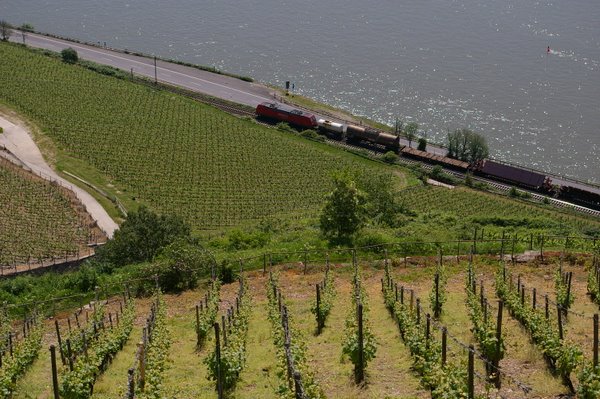
The Rheingau
Germany
is a remarkable wine-producing country, responsible for truly world
class expressions of Riesling coming from an array of amazing
vineyards. But here in the UK – and also in many other places –
its wines are somewhat ignored, and not treasured in the way that
they should be.
In
part, this is because of the way the German wine industry pressed
the self-destruct button in the 1960s and 1970s by going
down-market. Rather than focusing on Riesling made from special
patches of land, the Germans decided it would be smart to seduce
customers with inexpensive off-dry Liebfraumilch and the like, made
from second-rate grape varieties such as Müller Thurgau, grown in
fertile soils that should really have been used for potatoes
or wheat.
The
introduction of the Seitz sterile filter in the 1940s and 50s helped
this cause by providing the technical means to make stable, cheap
sweet wines. Just stop fermentation early, whack the wine though a
sterile filter and there you have it: boringly insipid, sometimes
sickly wines that met with consumers’ tastes at the time. This
sort of wine is what Germany has become associated with.
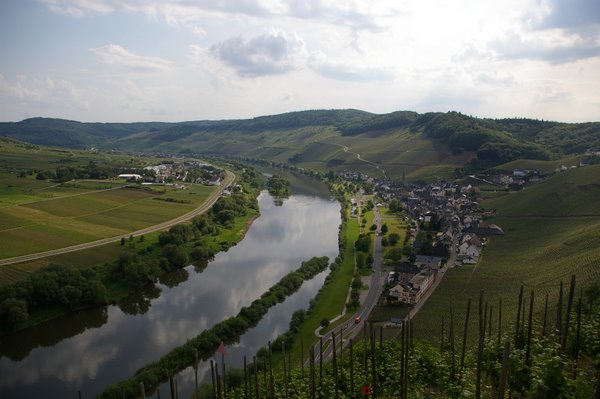
Looking
down to the village of Urzig from the Wurzgarten vineyard in the
Mosel
But
this has not always been the case. Look back to the first third of
the last century, and you’ll see from wine merchant lists that the
top German wines were as highly prized as the best from Bordeaux,
which is currently the world’s dominant fine wine region.
Here’s
a selection from London merchant Berry Bros & Rudd’s 1909
price list, with prices in shillings per dozen. (There were 20
shillings in the pound in those days; I haven’t worked out what
the equivalent value would be today, although I’m sure on the
internet there’s probably a facility somewhere that would make
this comparison possible.)
MOSELLE.
Zeltinger,
1900
...
... ... ... 42/-
Stephansberger, 1900
...
... ... 48/-
“Berncastler
Doctor.” 1900
...
... 54/-
” EX. QUALITY, 1900
...
... 66/-
” ” 1904
...
... 60/-
Graacher Hummelreich, 1893
...
... 66/-
HOCK.
Eltville
Sonnerberg 1904
...
... 60/-
Rudesheimer, Berg, 1900
...
... ... 66/-
”
” 1904
...
... ... 60/-
”
” Cabinet
1886
...
132/-
Steinberger,
1893
...
... ... ... 96/-
Steinberger Cabinet, 1876
...
... 90/-
Marcobrunner, Cabinet
1886
...
... 190/-
Schloss Johannisberg Cabinet–
Prince Metternich’s, 1893
...
... 200/-
” ” 1889,
144/-; 1884, 180/-
CLARET.
1904
Ch.
Talbot ...
... ... ... 30/-
Ch.
Pichon Longueville ...
... 33/-
Ch.
Gruaud Larose Sarget ...
34/-
Ch.
Canon, 1er
St
Emilion ...
36/-
1905
Ch.
La Mission Haut Brion Ch.bottled
42/-
Ch.
Margaux, 1st
growth ” 54/-
Ch. Latour, 1st
growth ” 50/-
Ch. Mouton Rothschild, ”
50/-
Ch. Haut Brion, 1st
growth ” 60/-
1899
Ch.
Léoville, Poyferré ...
... 42/-
” ” Lascases ...
... 45/-
Ch. Brown Cantenac ...
... 45/-
Ch. Lafite ...
... ... ... 72/-
1896
Ch.
Lafite ...
... ... ... 78/-
Ch. La Mission Haut Brion 72/-
1893
Ch. Léoville, Lascases ...
... 60/-
Ch. Cheval Blanc ...
... ... 78/-
1888
Ch. Smith Haut Lafite ...
... 72/-
1878
Ch. Lafite Ch.
Bottled ... ... 180/-
Ch. Palmer Margaux ...
... 96/-
1877 Ch.
Léoville ...
... ... ... 108/-
1874 Ch.
Larose, in
Wine Bottles ... 66/-
1870 Ch.
Margaux ...
... ... ... 90/-
1869 Ch.
Lafite, Grand
Vin, Ch. Bottled 200/-
It’s
interesting to do this comparison. People were willing to pay
equivalent prices for German Riesling as they were for the top wines
of Bordeaux. It’s unthinkable now.
But
when you visit Germany, look at the vineyards, and then taste the
wines in context, you can appreciate how special these wines are
(and I realize that I’m generalizing by including all German wines
together here in this way).
I
recently visited German vineyards for the first time. I know – I
should have gone before: it’s almost unforgiveable for someone in
my position not to have visited, for example, the Mosel. But in some
ways, I’m glad I delayed my visit, because I was able fully to
appreciate just how special these wine regions are, and how complex
and intriguing the wines they make can be.
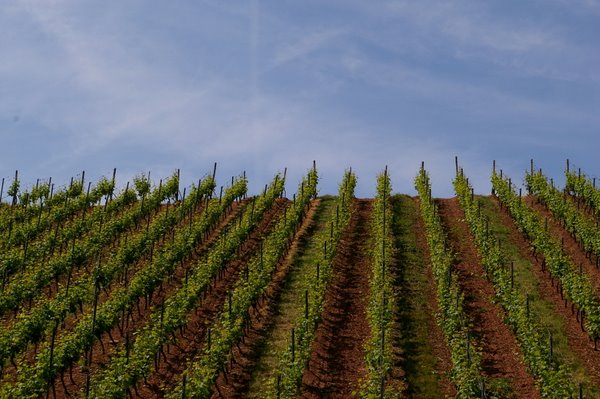
Vineyard
in the Rheinhessen
Some
background on Germany. Most of its top regions are relatively cool
climate, and to get enough warmth to ripen the Riesling grapes
sufficiently, many of the leading vineyards make use of south-facing
slopes, on the banks of rivers.
Of
course, there’s more to German wine that just Riesling. Warmer
regions such as the Pfalz and Baden specialize in a wide array of
other varieties, including Spätburgunder (the German name for Pinot
Noir). But while these wines can be wonderful, it’s Riesling that
Germany excels with.
Germany
is, currently, one of the countries that has benefited from global
warming. The increases in average temperature in recent decades have
meant that marginal regions such as the Mosel, where it is sometimes
just a bit on the cool side to ripen Riesling, are now enjoying
fewer difficult vintages than they used to, and more high quality
vintages.
If
you are new to German wines, reading the label can be a bit of a
problem. Let’s take Mosel wines as a starting point, because these
are the ones you’re more likely to encounter. As an example, we
might see the following:
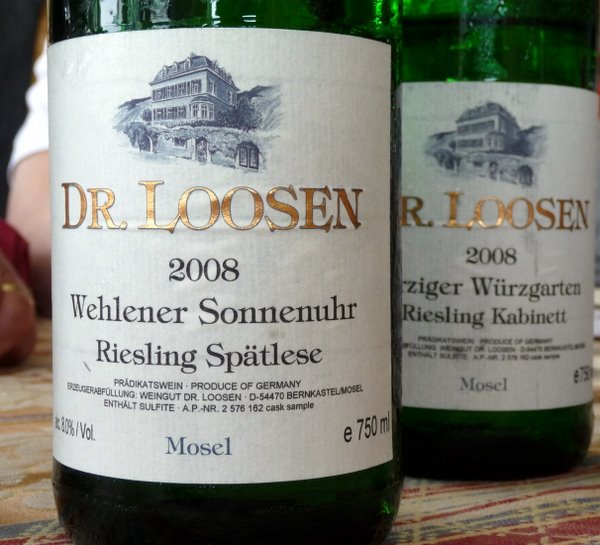 Dr
Loosen is the producer. Mosel is the region. 2008 is the vintage.
All straightforward. Then we have the long bit. Sonnenuhr is the
name of the vineyard, and because it is located in the village of
Wehlen, the prefix Wehlener is added. Riesling is the grape variety.
Spätlese means ‘late harvest’, and is one of the words used as
an indicator of the sweetness levels of the grapes in what is known
as the Prädikatswein system, which we’ll return to in a
second. All German wines also have what is known as an AP number,
which is a unique identifier of each lot of wine that is bottled. Dr
Loosen is the producer. Mosel is the region. 2008 is the vintage.
All straightforward. Then we have the long bit. Sonnenuhr is the
name of the vineyard, and because it is located in the village of
Wehlen, the prefix Wehlener is added. Riesling is the grape variety.
Spätlese means ‘late harvest’, and is one of the words used as
an indicator of the sweetness levels of the grapes in what is known
as the Prädikatswein system, which we’ll return to in a
second. All German wines also have what is known as an AP number,
which is a unique identifier of each lot of wine that is bottled.
This
is where things start to get complicated. For German whites there
are two main styles. The first is the ‘fruity’ style, and the
second is the dry style, known as Trocken. For Mosel Riesling, the
fruity style (off-dry, ranging through to sweet) is the most
commonly seen in the UK, although trocken wines are very popular in
Germany and most producers will now do, on average, a 50:50 split
between their fruity and trocken styles.
Quality
German wines are classified as either QbA (for Qualitätswein
bestimmter Anbaugebiete), the lower level, or as part of the
Pradikatswien system, where the different levels are classified on
the basis of sugar content of the must into Kabinett, Spätlese,
Auslese, Beerenauslese and Trockenbeerenauslese. Eiswein is a
separate category, made from grapes naturally frozen on the vine.
The most important of these categories are the first four:
Beerenauslese (BA) and Trockenbeerenauslese (TBA) are very sweet,
very expensive wines made from botrytised grapes which you won’t
see very often.
Why
are German wines often sweet when the fashion is for dry wines? Why
not just make all wines in the dry (trocken) style? It is a question
of balance. German Rieslings can be quite delicate wines, with high
acidity, and a bit of sweetness brings them into balance where they’d
be a bit austere and off-putting bone dry. Qba and Kabinett are just
off-dry, with lovely delicacy and high acidity levels. These are
made from the least ripe of the harvested grapes and so the high
acidity levels do need a bit of balancing by sweetness.
Interestingly, well made examples will have some sugar, but the
counteracting effect of the acid will make them seem drier than they
are.
Spätlese
means late harvest, and these wines will typically be a little riper
and sweeter. Trocken examples often work quite well, because the
later harvest means a riper, fruitier character is present in the
grapes, and so they don’t seem so austere. Auslese (selected
harvest) wines are sweeter still, and this is where many producers
make their top wines. Confusingly, some winemakers will make small
lots of special Auslese, which they might designate with asterisks,
or the use of a gold capsule (Goldkapsel). These are called
Goldkapsel or long Goldkapsel, and they’re usually really
expensive.
I
should also mention here the relatively new classification called Grosses
Gewachs, which is a new designation for the top dry wines from
special vineyard sites, and stands for 'great growth'. It's
currently an unofficial designation.
Here’s
a quick guide to Germany’s different regions.
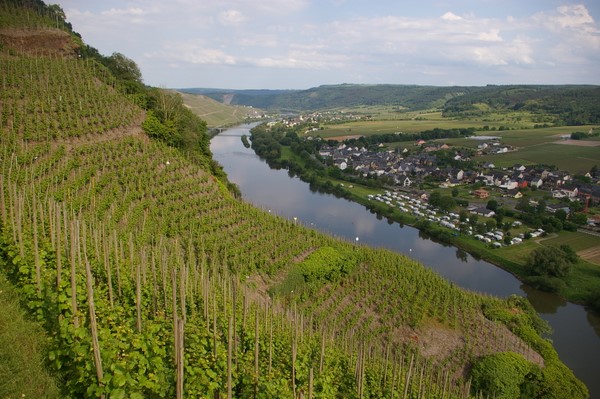
Urziger
Wurzgarten in the Mosel: Erden is the village over the river
Mosel-Saar-Ruwer
One
of Germany's great wine regions (actually, more correctly three
separate neighbouring regions making similarly styled wines - now
you can find the names used separately on the labels), named after
the three interconnecting rivers along whose banks the vineyards are
sited. It's a northerly region, right at the limits of where grapes
can ripen, and so the vineyard site is the key to quality here: the
best wines are made from Riesling grapes grown on the steep
hillsides overlooking the river. These wines are fresh, delicate,
mineralic, with racy acidity and low in alcohol, and are among the
world's greatest expressions of the Riesling grape. As with other
German regions, quality can vary hugely between the best and the
worst producers.
Nahe
Another
German wine region named after the river that it's arranged around,
the Nahe is small, fragmented and generally keeps a low profile. But
with a slightly warmer climate than some of the more northern
regions, it makes some lovely, intense white wines from the Riesling
grape. The best wines come from the hillside vineyards.
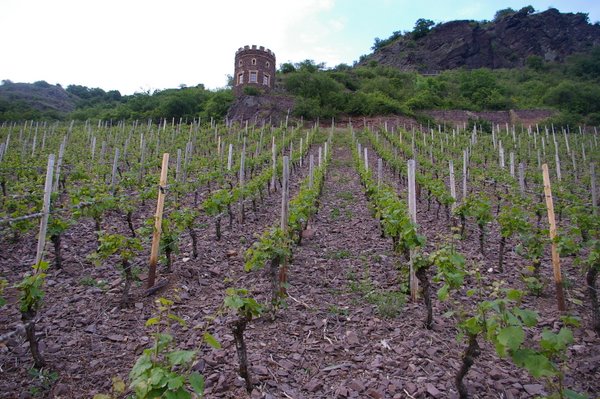
Felsenberg:
a Nahe vineyard
Pfalz
This
warm, southerly region is Germany's most productive. Although many
of the vineyards here make inexpensive commercial wines of the sort
that has given the German wine industry such a poor reputation
(about 50% of the Liebfraumilch produced comes from the Pfalz),
subregions such as the Mittelhardt do produce high quality wines,
mainly from the Riesling grape.
Rheingau
This
small region on the north bank of the Rhine near Mainz in Germany's
most aristocratic. The south-facing hillside vineyards produce some
of the world's greatest expressions of the Riesling grape, which
need long ageing to show their best and are a little fuller than the
lighter wines of the Mosel-Saar-Ruwer.
Rheinhessen
Immediately
south of the aristocratic Rheingau region, on the other side of the
Rhine river, this large German region makes wines of hugely varying
quality. On the one hand there are some top quality estates in the
nine villages known collectively as the 'Rheinterrasse'; on the
other hand this is the region responsible for half of all
Liebfraumilch produced (the rest comes from the Pfalz).
Franconia
This
is an interesting region, centred on the town of Wurzburg in
southern Germany. Its distinctive bocksbeutel (flask shaped bottle)
is still used by most producers. The wines here can be really
interesting, and Riesling isn’t the sole focus. This is one of the
regions that can actually do some interesting things with the
Müller Thurgau grape variety.
Baden
Large
southern German wine region which runs along the French border, over
the Rhine from the Alsace. You'd think that with it's southerly
location it would be a better place to grow grapes than Germany's
chilly northern regions, but the wines from Baden, while often soft
and reliable, rarely hit the peaks. The key grapes here are
Müller-Thurgau, Spätburgunder (the German name for Pinot
Noir), Weissburgunder (Pinot Blanc) and Grauburgunder (Pinot Gris);
Riesling is just a minor player. And unlike the other German
regions, the wines from Baden are mostly dry in style.
So,
if I wanted to explore German wine, where would be the best place to
start? I think Riesling should be the entry point, and I’d look
out for QbAs, Kabinetts and Spätleses from good quality producers.
In the UK, Dr Loosen’s QbA is available about everywhere and is a
great starting point. Leitz, from the Rheingau, are also well
represented, and their wines are solidly reliable. The following
list of producers is a useful start as a shopping list, although
this is by no means an exclusive list of all the great German
producers:
-
Loosen
-
Fritz
Haag
-
Maximin
Grünhauser
-
Donnhöff
-
Reinhold
Haart
-
JJ
Christoffel
-
JJ
Prum
-
Willi
Schaefer
-
Egon
Müller
-
Leitz
-
Gunderloch
-
Markus
Molitor
-
Max
Ferd Richter
-
Keller
GERMANY
SERIES
 Part
1: Introduction Part
1: Introduction
 Part
2: Leitz, Rheingau Part
2: Leitz, Rheingau
 Part
3: Dönnhoff, Nahe Part
3: Dönnhoff, Nahe
 Part
4: Gunderloch, Rheinhessen Part
4: Gunderloch, Rheinhessen
 Part
5: Paul Furst, Franken Part
5: Paul Furst, Franken
 Part
6: Dr Loosen, Mosel Part
6: Dr Loosen, Mosel
Wines
tasted as 05/09
Find these wines with wine-searcher.com
Back
to top
|

